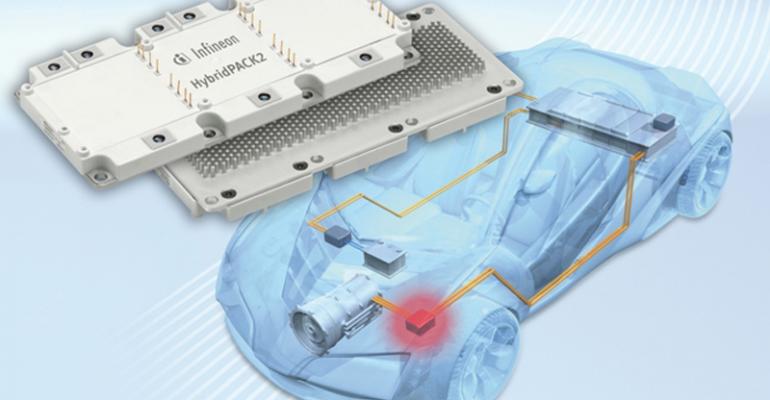PARIS – A German luxury brand is expected to introduce a 48V electrical circuit in tandem with a 12V circuit in 2015, five years before millions of cars using the technology could be on European roads.
Suppliers and auto makers at the biennial CESA automotive electronics conference here are counting on mild hybrids with 48V lithium-ion batteries to reduce fuel consumption in midsize cars 5%-10%.
And just as with diesel, motorization in Europe seems to be moving in a direction different from that of North America.
“I don’t know of any North American activity for 48V,” says Khamis Kadiri, innovation manager-E/E architecture at PSA Peugeot Citroen. “We expect to use (the technology) if it is standard. There is an existing specification, made by the German OEMs but shared by a lot of suppliers and some other OEMs,” including Renault.
Germany’s major auto makers decided two years ago to add a 48V subsystem, and early on PSA was aware of its possibilities from its engine-development work with BMW.
Renault is working on engines with Daimler, and electronics supplier Valeo committed to 48V development early.
The first German 48V system, expected in 2015, may be for a feature other than a mild hybrid, simply to provide engineers with experience.
Gabriel Wetzel of supplier Robert Bosch says, “We give start of production in 2015 and 2016 as the start in the market. To have a large number of cars (using the technology) in 2020, you need to ramp up very fast. We believe that all manufacturers will start with significant volumes.”
Kadiri says PSA will launch its first 48V system strictly for the mild-hybrid application in 2017. BMW’s Ottmar Sirch says the German OEMs will introduce their mild-hybrid systems between 2016 and 2018.
“It is not easy to put such a change in the cars,” says Sirch. “Between 2016 and 2020, we see the ramp-up of this functionality.”
A mild hybrid incorporates stop/start battery technology and can travel short distances at low speeds using only electric power, but the electric motor mainly helps the internal-combustion engine launch the vehicle and assists under high-load conditions.
An earlier attempt to change the entire vehicle’s electrical system to 42V failed, mainly due to expense, but the 48V system is seen as an addition. It mainly will assist energy recovery and stop/start, but also will be available to boost torque and handle heavy electrical users like electric power steering and rear-window defrosting.
Wolfgang Bernhart, an expert in electrified powertrains at Roland Berger Strategy Consultants, says that in 2020, if no particular government subsidies are in place, 94.7% of cars sold in North America still will have conventional powertrains, 2.4% will be full hybrids, another 2.4% will be plug-in hybrids, 0.3% will be electric and just 0.2% mild hybrids.
In Europe, he expects 70.1% of vehicles to have standard powertrains, 25.8% will be mild hybrids, 2.5% will be plug-ins, 1.4% will be electric and 0.2% will be full hybrids.
Says Bernhart, “We expect that optimization of powertrains will bring most OEMs relatively close to the target” of 95 g/km of carbon dioxide in 2020, the equivalent of 56 mpg (4.2 L/100 km) for gasoline-powered engines and 60 mpg (3.9 L/100 km) for diesels.
“Mild hybridization is cheaper than hybrid technology and will save 4 or 5 grams of CO2,” he adds.
The German auto makers decided on the 48V standard two years ago, and through the VDA industry association have been defining the specifications to be met.
Sirch says the final technical specifications were published in German Dec. 1, and Volkswagen will have them translated early in 2013 into English and other languages used by suppliers. A preliminary version has been available in English since June.
Recovering energy during braking or deceleration with 48V is twice as efficient than with 12V, he says. “If you can save 5%-10% with 48V, you could save only 2.5% to 5% with 12V. And with 12V, boosting would be zero.”
Some start/stop systems in Europe recover braking energy, such as the PSA version supplied by Valeo in its diesel hybrids with an electric rear axle. The current version uses ultracapacitors to grab energy more quickly than the lead-acid battery and provide a little boost, but a 48V system with a Li-ion battery can do more.
“An increase of onboard electrical needs alone won’t justify changing the voltage network,” says Frank Briault, a PSA engineer who worked on the current start/stop system. “But each gram of CO2 which is saved, we accept (having) to pay for that. New functions will appear on vehicles.”
For example, he says, the current stop/start system turns off the engine during deceleration at 12 mph (20 km/h), but with 48V, the system will have enough power to turn it off at higher speeds and still restart imperceptibly when the driver accelerates.
PSA’s Kadiri says the auto maker’s first 48V system in 2017 will be used strictly in the mild-hybrid application, and after getting experience with the basics the car company will expand the network to handle some secondary functions a year or two later.
“We are defining the scenario for products and how to generalize it in our cars,” he says. “The first system is the mild hybrid, and with that we will have the DC/DC converter, the inverter and the battery.”
While the theory is clear, Kadiri says making it a reality depends on the industry adopting standard components, so different auto makers can use the same power electronics and batteries, for example. “If each solution is unique, it will not meet cost goals, and not be interesting for consumers.”
If other companies develop 48V products using the German specifications, BMW’s Sirch predicts, “this will be a base that will help suppliers and sub-suppliers offer their solutions to car manufacturers in Germany, France or anywhere.”





